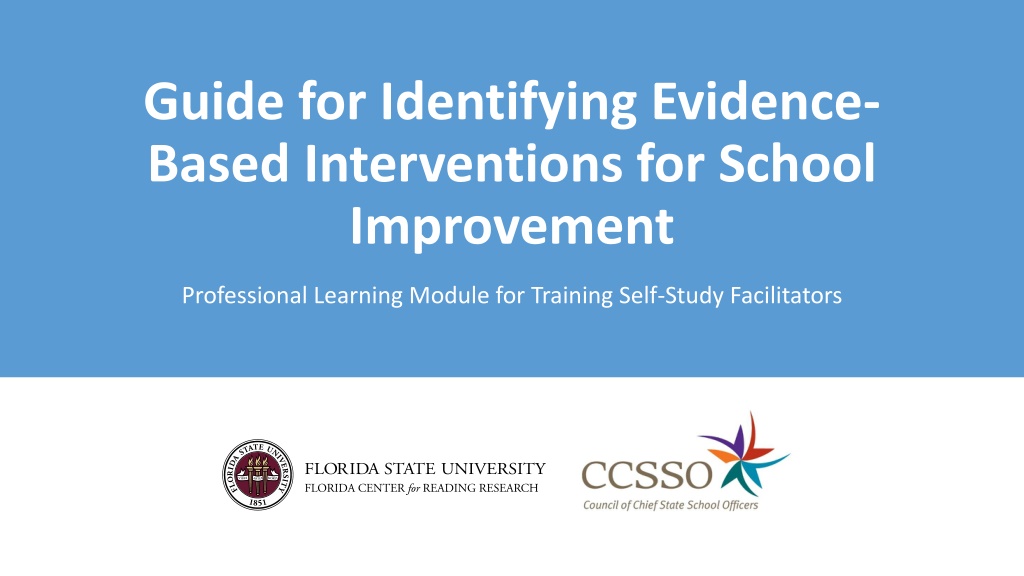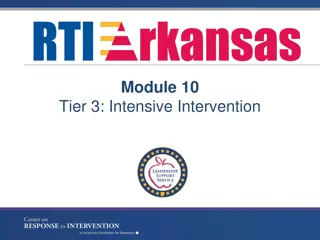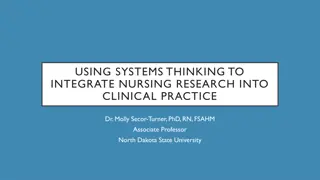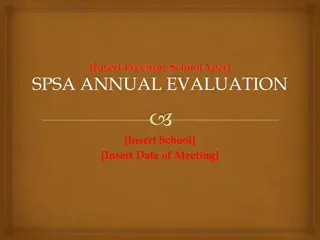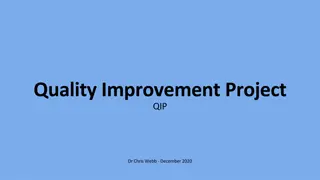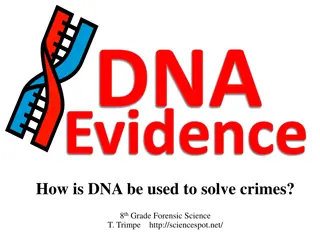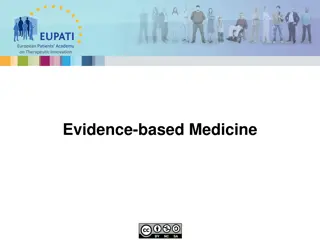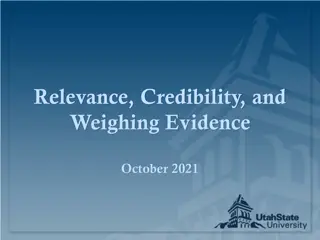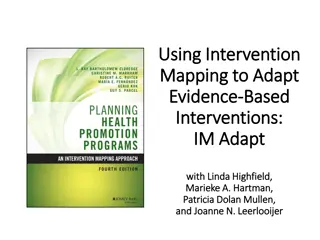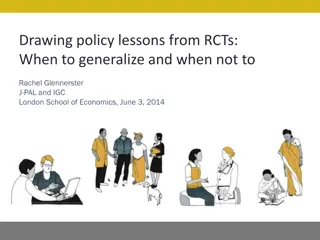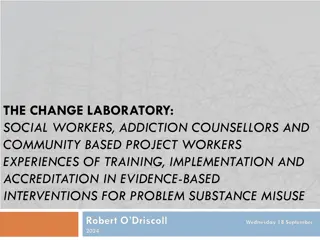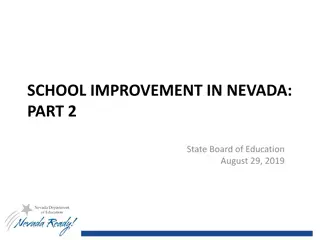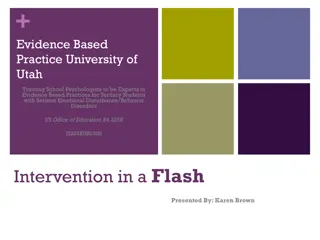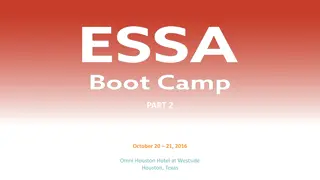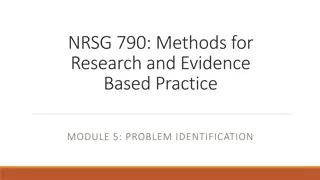Guide for Identifying Evidence-Based Interventions in School Improvement
This guide focuses on leveraging evidence-based interventions for school improvement, covering topics like the self-study process, ESSA requirements, and support for schools in need of comprehensive or targeted assistance. It emphasizes the importance of data-driven decision-making and collaboration among stakeholders to enhance student performance.
Download Presentation

Please find below an Image/Link to download the presentation.
The content on the website is provided AS IS for your information and personal use only. It may not be sold, licensed, or shared on other websites without obtaining consent from the author. Download presentation by click this link. If you encounter any issues during the download, it is possible that the publisher has removed the file from their server.
E N D
Presentation Transcript
Guide for Identifying Evidence- Based Interventions for School Improvement Professional Learning Module for Training Self-Study Facilitators
Agenda Welcome and Housekeeping The goal of this session is to enable participants to serve as effective facilitators of a self-study in their agency, district, or school, utilizing the Guide of identifying Evidence-Based Interventions for School Improvement. Content for the Session: ESSA and the Guide for Identifying Evidence-Based Interventions for School Improvement The Self Study Process Conducting Self-Study Exploring the Guide and the Role of the Facilitator Reflection and Summary 2
ESSA and the Guide for Identifying Evidence-Based Interventions for School Improvement 3
Requirements of ESSA Schools in Need of Comprehensive Support States must notify each local educational agency (LEA) in the State of any school that is identified for comprehensive support Each notified LEA must in partnership with stakeholders, develop an improvement plan that: Includes long-term goals for student performance Includes evidence-based interventions Is based on a school-level needs assessment Identifies resource inequities Is approved by the school, LEA, and the State education agency Is monitored and periodically reviewed by the SEA 4
Requirements of ESSA Schools in Need of Targeted Support States must notify each local educational agency (LEA) in the State of any school served by the local educational agency in which any subgroup of students is consistently underperforming LEAs must notify schools with respect to which subgroup of students in such school are consistently underperforming Each notified school must in partnership with stakeholders, develop an improvement plan that: Includes long-term goals for student performance Includes evidence-based interventions Is approved by the LEA Is monitored by the LEA Results in additional action following unsuccessful implementation of such plan after a number of years determined by the LEA. 5
What is the Purpose of the Guide? The Guide for Identifying Evidence-Based Interventions for School Improvement is intended to help SEAs and LEAs carefully consider the evidence supporting intervention options that they will require or recommend in their state ESSA plan, school improvement plans, and funding applications. SEAs could indicate in their state ESSA plan how they have used or will use the self-study process to identify interventions, in partnership with stakeholders. 7
What are the Goals of the Guide? The purpose of the guide is to help self-study teams: Evaluate the evidence base for interventions that may be considered for use in schools in need of comprehensive or targeted support Determine the interventions that have strong evidence and are relevant and appropriate to meeting the needs of schools Plan to provide resources for schools to help them choose or implement interventions. 8
How Does the Guide Help? The guide provides the following to help self-study teams meet their goals: A process for a variety of stakeholders to be involved in decision-making through their participation on the self-study team A structure for focused and thoughtful conversations A variety of tools to record the thoughts of the self-study team regarding selection of interventions and planning for successful implementation A procedure for decision-making and follow-through 9
School Improvement Opportunities Under ESSA Choice States and LEAs may select interventions they deem best for their schools in need of comprehensive or targeted support. Flexibility ESSA provides the following flexibility to states: create a list of evidence-based interventions for schools in need of comprehensive or targeted support from which local education agencies (LEAs) must choose allow LEAs to select evidence-based school improvement interventions themselves Choice and Flexibility may lead schools to implement interventions that are targeted to their needs and have the strongest level of evidence-base possible, thereby improving student achievement. 10
The Need for Discussion and Decision-Making Choice and flexibility come with responsibility Decisions must be made Is the evidence-base of an intervention sufficient? Does the intervention meet the needs of the school(s)? How can we ensure successful implementation? What resources need to be developed? What time and financial investments will need to be made? How will follow-up occur? How will we define and track success? 11
Considering Context ESSA requires that a needs assessment be conducted to determine issues that should be addressed at schools in need of targeted and comprehensive support. Interventions that are selected for use in schools needing improvement should be those that address the issues identified in the needs assessment, have the highest evidence-level possible, and be those that the school has the feasibility to implement and sustain. 13
What is Self-Study? Self-study provides a structure for collaboration and decision-making. The process involves establishing a team of stakeholders and using a guide with predetermined focus areas and questions to collect, share, and discuss information. It may also provide an opportunity for team members to suggest additional focus areas for consideration. 15
The Self-Study Process Recruiting a Team Identifying a Self-Study Team - It is preferable to invite people with a wide variety of background and roles to be a part of the team. Discuss the following questions at your tables and be ready to share your thoughts with the whole group: Why would it be important to include a wide variety of participants? What kinds of team members would you include, considering that you are making decisions regarding school improvement interventions? How many team members do you think would be appropriate? What characteristics should team members possess considering that they will be doing both individual and collaborate work? 16
The Self-Study Process The Role of the Facilitator Facilitators have an integral role in the success of the self-study process. You may have been chosen as a potential facilitator by leadership in your organization, or a self-study team that has already been established may have selected you. The responsibilities of the facilitator include: Organizing and distributing documents associated with the self-study including the guide itself Instructing the team members in how to engage in individual work that may involve completing the scoring template and scoring guide Leading discussions Scheduling meetings to review the guide for voting, collaboration, and planning after individual work has been done For subsequent follow-up as necessary At your tables, chart characteristics of a good facilitator taking into account the responsibilities above. 17
The Self-Study Process The Role of the Facilitator The Facilitator s Checklist (pg. T-10) may help the facilitator keep track of tasks that need to be completed: 18
SEA Guide for Identifying Evidence-Based Interventions for School Improvement 21
LEA Guide for Identifying Evidence-Based Interventions for School Improvement 22
Step One of Self-Study - Preparing for Collaboration Individual Work for the Facilitator Schedule meeting with team members to review the guide Distribute documents to team members Schedule meeting following individual team work Individual Work for Team Members Review the Guide, reading carefully the section on collecting and evaluating research Search for and identify a school improvement intervention to present to the self-study team for consideration Collect and evaluate the evidence-base of the intervention Formulate questions that may help team members thoughtfully consider the intervention Cite the research gathered Individually rate evidence-based interventions provided by the facilitator as not recommended, recommended, or strongly recommended Note any questions to bring to the team meeting 23
Step Two of Self-Study Participating in Discussion Team members share their rankings of school improvement interventions as not recommended, recommended, or strongly recommended. The facilitator guides a discussion following the vote in an effort for the team to come to consensus regarding each of the interventions. 24
Step Three of Self-Study Planning Next Steps The facilitator leads a discussion regarding planning for next steps, recording priorities and ideas of the team along with any anticipated challenges. Timelines for follow-up are established and future meetings are established. 25
Exploring the Guide and the Role of the Facilitator 26
Exploring the Guide and the Role of the Facilitator An Overview Narrative Sections Table of Contents Introduction The Self-Study Process Overview of the Self-Study Guide Tools Preparing for Self-Study Follow-up, Monitoring, and Evaluation Self-Study Tools Checklists for Team members and Facilitators Scoring Template Scoring Guide Voting and Consensus Rating Form Planning Form 27
Exploring the Guide and the Role of the Facilitator Sections for Preparation Team members may need to use the following sections to conduct independent work before meeting for discussion: Preparing for Self-Study Checklist Scoring Template Scoring Guide Appendix A Annotated Bibliography The facilitator will need to decide if all of the components will be utilized by team members, or if only some of them are appropriate to their needs. The facilitator may also wish to use the Facilitator s Checklist to ensure all tasks are completed. 28
Exploring the Guide and the Role of the Facilitator Sections for Preparation: Collecting and Evaluating Evidence At your table: In the Preparing for Self-Study section, read the information concerning the process, collecting research, and evaluating research. Discuss the following questions: Are the characteristics of a good facilitator listed in the guide reflective of those that your group listed? How does the facilitator seem to keep the process flowing? Are there other resources that you know of where research to identify evidence-based interventions might be found? If so, write them on sticky notes. Are there other organizations that you know of that could help in the evaluation of research? If so, write them on sticky notes. 29
Exploring the Guide and the Role of the Facilitator Sections for Preparation: ESSA Levels of Evidence In your groups: Everyone read the section on the ESSA levels of evidence on pages 13-14. Discuss the following questions: What is meant by statistically significant ? What is meant by substantively important ? Why are these important? Why is context of the studies important? Why can demonstrates a rationale be considered an opportunity for building evidence? 30
Exploring the Guide and the Role of the Facilitator Sections for Preparation: ESSA Levels of Evidence In your groups: At least one person reads the section on strong evidence (pgs. 14-16) At least one person reads the section on moderate evidence (pgs. 16-17) At least one person reads the sections on promising evidence and evidence that demonstrates a rationale (pgs. 17-18) After reading: Explain the section you read to your group. Be sure to note the critical components of studies falling into the evidence-level, what constitutes being well-designed and well-implemented, and some look-fors that reflect the evidence-level you read about. 31
Exploring the Guide and the Role of the Facilitator The Scoring Template With a partner at your table: Review the data from ABC Elementary School and determine a top priority in the school. Select one of the interventions found on one of the websites (pg. 12) that you think addresses the priority of the school you identified, and has an evidence- base that satisfies your group. Work together to complete the scoring template, except for the selection of the rating. Your group will need to think about what additional information might be available to help evaluate the intervention, and develop at least two guiding questions that might help others as they consider whether this is an appropriate choice for the school. 32
Exploring the Guide and the Role of the Facilitator Sections for Preparation: The Scoring Guide Individually, read through the interventions in Area 1, Implementing Systemic Change (pgs. T-20 toT-25). Consider the needs assessment of ABC Elementary School and the evidence-level of these interventions. Reference Appendix A. Annotated Bibliography (pg. A-1) for additional information regarding the research. Rate each intervention as not recommended, recommended, or strongly recommended. 33
Exploring the Guide and the Role of the Facilitator Discussion and Planning At your tables review the following documents that are used to record the thoughts and ideas of the self-study team members: Initial Voting Worksheet (supplemental document) Consensus Rating Form (pg. T-47) Planning Form (pg. T-50) 34
Exploring the Guide Discussion, Planning and the Role of the Facilitator Each table group shares out two characteristics of a good facilitator from the charts created earlier. Brainstorm at your tables: What are examples of ways the facilitator can encourage the conversation? What can the facilitator do to ensure that one or two team members do not monopolize the conversation? What can the facilitator do to involve team members who are not as comfortable sharing their opinions? How can the facilitator ensure that he or she captures the thoughts and ideas of the team members accurately? 35
Practicing the Role of the Facilitator Take turns practicing facilitation using the completed scoring templates and the completed scoring guide for the interventions in Area 1. Each person at the table will facilitate the conversation pertaining to ONE intervention. The facilitator records the initial votes of team members using the initial scoring worksheet. The facilitator leads the discussion ask team members to explain why they voted the way they did. Attempt to reach consensus Conduct a consensus vote using the Consensus Rating Forms Work through two questions on the Planning Form 36
Reflection At your tables discuss: What went well? What will you need to practice? What did you learn? 38
Reflection Whole Group Discussion: What are the overall benefits of this process? Why is it helpful to have a structure when engaging in this work? Why is it beneficial to have team members who hold a variety of roles and have expertise in different areas? What are next steps when I return to my agency, district, or school? 39
In Summary ESSA provides flexibility and responsibility to states and school districts to select interventions for their schools in need of comprehensive or targeted support. The Guide for Identifying Evidence-Based Interventions for School Improvement and the self-study process provide a structure to help in the decision-making process. The guide encourages the selection of interventions that meet the needs of the school and are evidence-based. Both individual and group work are a part of the process. The facilitator is critical to the implementation of the guide. 40
Resources and Contact Information The guide and resources that support it may be found at: http://essa.fsu.edu For additional information regarding the guide or its use please contact: Laurie Lee Florida Center for Reading Research llee@fcrr.org 850-644-1953 41
